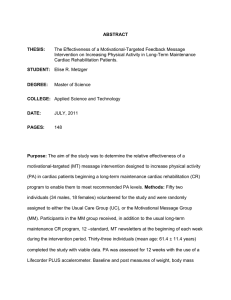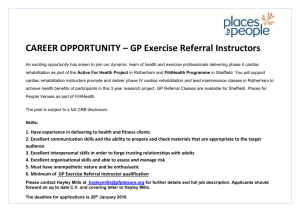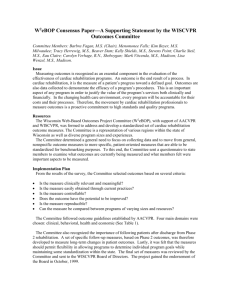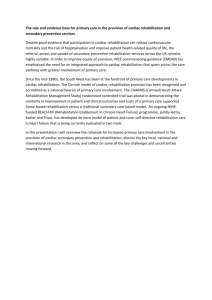Angela Tod “Trusting the body” and “looking to the attack
advertisement
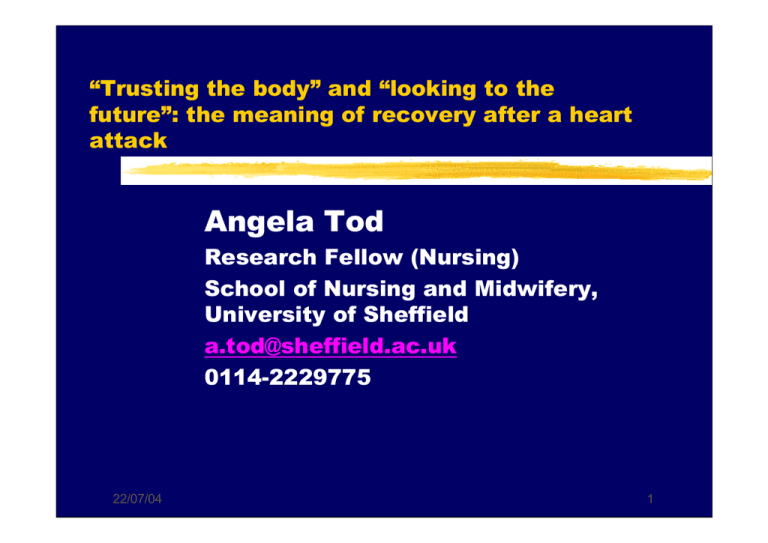
“Trusting the body” and “looking to the future”: the meaning of recovery after a heart attack Angela Tod Research Fellow (Nursing) School of Nursing and Midwifery, University of Sheffield a.tod@sheffield.ac.uk 0114-2229775 22/07/04 1 Presentation Overview • Project overview • Background • Results • Key messages 22/07/04 2 Project Overview Ø Stage 1 Ø Stage 2 Ø Overcoming barriers to accessing cardiac rehabilitation services Ø MI recovery experience and ability to access services Ø South Yorkshire Coalfields Health Action Zone Ø Identify barriers to accessing current services. Ø Patients, staff and carers Ø Tod, Lacey, McNeill (2002) JAN 40(4), 421-431 Ø Explore the patient pathway from MI to recovery Ø How do people experience recovery? Ø What defines recovery? Ø What do people need to do to get to a point of recovery? Ø What are the related service needs? Ø How does this compare to current services provision and access? 22/07/04 3 Cardiac rehabilitation ¤ “the sum of activities required to influence favourably the underlying cause of the disease, as well as the best possible, physical, mental and social conditions so that they (people) may, by their own efforts preserve or resume when lost, as normal a place as possible in the community. Rehabilitation cannot be regarded as an isolated form or stage of therapy but must be integrated within secondary prevention services of which it forms only one facet (World Health Organisation, 1993). 22/07/04 4 Cardiac Rehabilitation? Ø Multi-factorial Ø Multi-disciplinary Ø Menu based Ø Individualized / patient focused Ø Component of secondary prevention Ø Phases 22/07/04 5 Background Ø Our Healthier Nation / National Service Framework Ø National and local inconsistencies in content, standard and quality of services Ø In the UK there are National and local inequalities in access to services: ¤ ¤ ¤ ¤ ¤ current service limited to low risk patients programmes hospital based some populations excluded poor access by women, ethnic minority groups and the elderly non attendance linked to levels of deprivation and education Ø Literature focuses on adjustment, coping and adaptation but not recovery 22/07/04 6 Local Background Ø Cardiac rehabilitation in South Yorkshire Ø Phase 1, Pre discharge ØMost M.I. patients seen by nurse and/or physiotherapist Ø Phase 2, First few weeks post discharge ØLimited community provision by mixture of HV, practice nurse and district nurses Ø Phase 3, 6 weeks post-discharge ØLimited hospital based exercise and education class Ø Phase 4, long term maintenance ØScarce provision, patches of activity 22/07/04 7 Study one Ø AIM: To explore what barriers exist for patients accessing M.I. Cardiac rehabilitation services within the South Yorkshire Coalfields Ø DESIGN: A qualitative study utilizing semi-structured interviews and framework analysis techniques Ø Framework analysis (Ritchie & Spencer, 1994) Ø Ø Ø Ø Ø Familiarisation Developing a thematic framework Indexing Charting Mapping and interpretation Ø September 2000 to July 2001 22/07/04 8 Sample Ø Staff (15) Ø Individual interviews, workplace, 20-30 minutes Ø Hospital: CR Nurse, CCU Nurse, Nurse Manager, CR physio, Physio Manager, Dietician, Dietetics Manager Ø Health Authority: Exercise Development Worker, Public Health / Health Promotion Ø Primary Care: Pharmacist, Practice Nurse, Health Visitor Ø Other: Fitness Instructor Ø Group of 7 HV’s 22/07/04 Ø Patients (20) Ø Individual interviews, own home, 20-30 minutes Ø Range of age, sex, post code, c.rehab attendance, occupation Ø 6-8 months post MI Ø Exclusion: co=morbidity, mental distress, unable to be interviewed / give consent Ø Group of self help group volunteers 9 Results - themes Ø Ø Ø Ø Ø 22/07/04 absence and abandonment waiting and delays communication and confusion understanding and expectations appropriateness 10 Absense and abandonment Ø Ø Ø Ø Limited service capacity 4 seen by community nurses 3 attended hospital class Time services absent and needed: post transfer, 2 weeks post discharge, 6-8 weeks: “I think as soon as you come out of hospital, you need some sort of guidance because that is the critical time not six months afterwards” “I’d done as much exercise as I could and I was waiting for the next bit to kick in and obviously not hearing anything” Ø Reassurance Ø Ø Ø Ø 22/07/04 Exercise advice Psychological support Personalised support Family and partner support 11 Waiting, Communication and Understanding, Ø Waiting Ø Limited capacity Ø Waiting lists Ø Exclusion criteria Ø Impact of waiting Ø Communication systems and processes Ø Understanding Ø Of cardiac rehabilitation Ø Of CHD causes and experience of MI 22/07/04 12 Appropriateness Ø Groups and Location Ø Women Ø Commitments and responsibilities Ø Social norms Ø Elderly Ø Routine Ø Location Ø Misunderstanding Ø Men Ø Macho culture Ø Stoicism and reticence 22/07/04 13 Study two Ø MI recovery experience and ability to access services Ø Explore the patient pathway from MI to recovery Ø Research questions ØHow do people experience recovery? ØHow do people conceptualise recovery? ØWhat do people need to do to get to a point of recovery? ØWhat are the related service needs? ØHow does this compare to current services provision and access? 22/07/04 14 Sample and Methods Ø Sample Ø Members of phase 4 or cardiac support groups Ø Four groups (3-9) Ø Recruited from group workshop in study one and from support groups 22/07/04 Ø Methods Ø Semi-structured interviews Ø Testing experience compared to study one participants Ø Exploring recovery Ø Framework analysis Ø Grounded theory Ø Open/axial/selective coding Ø Theoretical sampling of stage one participants Ø Constant comparison and testing of data 15 Pathway from MI to recovery MI 22/07/04 Recovery process mediated by coping mechanisms RECOVERY 16 Paradigm model Paradigm model of Straus & Corbin 1990 used to structure findings Causal conditions? phenomenon ? context ? intervening conditions ? action / interactional strategies ? consequences Heart attack ? Heart attack recovery ? Recovery experience ? Stage one 1) South Yorkshire Culture 2) Services to support recovery ? Recovery coping mechanisms ? Extent of recovery (against certain Characteristics that were seen to define recovery) 22/07/04 17 Recovery experience (context) Ø Different person Ø Sudden, out of the blue Ø Emotional: ØFrightened, vulnerable, irritable, depressed, anxious, frustrated, loss Ø Physical: ØTired, fatigued Ø Understanding: Ø uncertain, confused, forgetful, questioning Ø Why me? Am I allowed? Ought I to? Ø Social: Ø Isolated, restricted, mollycoddled, no-control 22/07/04 18 SY society and services (intervening conditions) ØSouth Yorkshire culture ØMacho ØStoical ØTraditional roles / commitments ØCardiac rehabilitation services ØGap between service need and experience demonstrated in Study one. 22/07/04 19 Recovery coping mechanisms (action/interactional strategies) Ø Taking control Ø Getting information Ø Getting on with it / resuming activities Ø Attribution Ø Seeking explanations Ø Comparing Ø Redefining Ø Reset limits Ø Reprioritise Ø Set new targets / goals 22/07/04 20 Elements of recovery How do people characterise recovery Confidence Control Information/knowledge Looking to the future 22/07/04 Trusting the body 21 What service is needed to facilitate recovery? Ø What did people require from the service in order to help them them mobilize their recovery / coping mechanisms and to move along the pathway to recovery? Ø Nature of the service: continuity, individualized: Ø Listening Ø Taking time Ø Personalized information and care Ø Content of the service: explanations, someone to talk to, home visit, assessment/monitoring, meeting others in the same position Ø Staff attitude: honesty, knowledgeable, reassuring, caring 22/07/04 22 What service did they receive? Ø But experience of access matched that of participants in study one: Ø Ø Ø Ø Ø Ø Ø Ø Limited capacity Unmet expectations Lack of continuity Poor communication No time Waiting lists Access filters Inappropriate Ø Highlights the potential that, without appropriate content & processes, services may delay people in achieving recovery 22/07/04 23 Key messages ØService structure and process need to reflect recovery process ØNeed for service redesign Ø primary care based Ø assessment / triage Ø individualized care ØValue of Framework analysis vs Grounded theory 22/07/04 24
